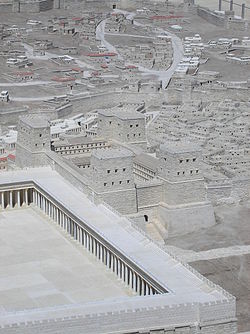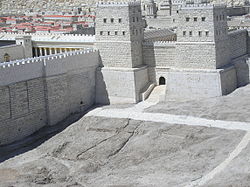Antonia Fortress


TheAntonia Fortress(Aramaic:קצטרא דאנטוניה)[a]was acitadelbuilt byHerod the Greatand named for Herod's patronMark Antony,as a fortress whose chief function was to protect theSecond Temple.It was built inJerusalemat the eastern end of the Second Wall, at the north-western corner of theTemple Mount,and was connected to the Temple byporticoes.
History
[edit]Herod (r. 37 – c. 4BCE) built the fortress to protect theTemple.He named it for his patronMark Antony(83–30 BCE).[1] The fortress housed some part of the Roman garrison of Jerusalem. The Romans also stored thehigh priest's vestmentswithin the fortress.[citation needed]
The fortress was one of the last strongholds of theJewsin theSiege of Jerusalem (70 CE),when the Second Temple was destroyed.[1]
Construction date controversy
[edit]The construction date is controversial because the name suggests that Herod built Antonia before thedefeatof Mark Antony byOctavian[2]in 31–30 BCE and Mark Antony's suicide in 30 BCE. Herod is famous for being an apt diplomat and pragmatist, who always aligned himself with the winning side and the "man in charge" of Rome. It is somewhat difficult to bring this date in accordance with the presumed date for the construction of the Herodian Temple.
Christian tradition
[edit]Traditionally,Christianshave believed for centuries that the vicinity of the Antonia Fortress was the site ofPontius Pilate'praetorium,whereJesuswastriedforhigh treason.This was based on the assumption that an area of Roman flagstones discovered beneath theChurch of the Condemnationand theConvent of the Sisters of Zionwas 'the pavement' whichJohn 19:13describes as the location of Jesus' trial.
Antonia pavement: archaeological counter-arguments
[edit]Pierre Benoit,former professor of New Testament studies at theÉcole Biblique,reexamined the results of all previous surveys of the north-western escarpment of the Haram, of the archaeological studies of the sites owned by the Catholics in the area (Convent of the Sisters of Zion,Flagellation MonasteryandSt Anne Conventof theWhite Fathers), as well as the digs north of theStruthion Poolarea,[2]and published in 1971 his conclusions: Archaeological investigation indicates that about a century after the presumed time of Jesus' death, this area was rebuilt as the eastern of twoforumsbelonging to the new city initiated byHadrianin around 130 CE, theAelia Capitolina,[2]and it is conceivable that following the destruction of the Antonia Fortress during the siege of 70 CE, its pavement tiles were reused at Hadrian's forum.[3]However, he also considers the possibility that the pavement is from Hadrian's time altogether.[2]The eastern forum of the Aelia Capitolina was built over the Struthion Pool, which was mentioned by first-century historianJosephusas being adjacent to the fortress (Josephus,Jewish War5:11:4).[citation needed]
Praetorium at royal palace, not at Antonia
[edit]There are textual and archaeological arguments against thetrial of Jesusbeing carried out at the Antonia Fortress. LikePhilo,Josephus testifies that the Roman governors stayed inHerod's Palacewhile they were in Jerusalem,[4]and carried out their trials on the pavement immediately outside it (Josephus,Jewish Wars,2:14:8). Josephus indicates that Herod's Palace is on the Western Hill (Jewish Wars,5:2) and in 2001 some of its vestiges were rediscovered under a corner of theTower of David.[5]Archaeologists therefore conclude that in the first century, thepraetorium—the residence of thepraefectus(governor)—was in the former royal palace on the Western Hill, rather than at the Antonia Fortress, on the opposite side of the city.[2]However, as the tradition retained its power in associating the fortress with Jesus' trial, the place where it once stood serves as the starting point of theVia Dolorosacommemorating thecrucifixion of Jesus.
Two arguments for Antonia as the place of judgement
[edit]1. During the greatest pilgrimage feast, when hundreds of thousands came to the Temple, Pilate naturally had to be with his garrison next to the Temple mount as a potential focus of the uprising, and certainly the favorite place of religious and national zealots who wished independence from Rome.[6]
2. According to Luke's Gospel (23:6–13), Pilate found out that Christ was from Galilee, "and when he knew that he was of Herod's jurisdiction, he sent him unto Herod, who himself also was at Jerusalem in these days" (23:7). Herod Antipas, who came for the holiday from Galilee to Jerusalem, disappointed and angry because of Jesus’ silence, "sent him back to Pilate" (23:11), who then "called together the chief priests and the rulers and the people" (23:13). It seems that Pilate was not in Herod's castle. If the trial had taken place in Herod's castle, he could have simply asked Herod to come to the courtroom, as he summoned the chief priests and the leaders.[7]
Description
[edit]Although modern reconstructions often depict the fortress as having a tower at each of four corners, Josephus repeatedly refers to it as "the tower Antonia", and states that it had been built byJohn Hyrcanusand later byKing Herod,and used for avestry,in which were reposited the vestments of thehigh priest.[8]Josephus states:
The general appearance of the whole was that of a tower with other towers at each of the four corners; three of these turrets were fiftycubitshigh, while that at the south-east angle rose to seventy cubits and so commanded a view of the whole area of the temple.[9]
Some archaeologists are also of the opinion that the fortress consisted only of a single tower, located at the south-east corner of the site.[10][dubious–discuss]For example, Pierre Benoit writes that there is absolutely no archaeological support for there having been four towers.[11][dubious–discuss]
Josephus attests to the importance of the Antonia: "For if the Temple lay as a fortress over the city, Antonia dominated the Temple & the occupants of that post were the guards of all three." Josephus placed the Antonia at the northwest corner of the colonnades surrounding the Temple. Modern depictions often show the Antonia as being located along the north side of the Temple enclosure.[citation needed]
Other theories
[edit]Some researchers and academics, including Marilyn Sams (M.A. in American Literature, Brigham Young University) and Dr.Robert Cornuke(Ph.D. in Bible and Theology, Louisiana Baptist University), have expanded on research by Dr.Ernest L. Martin(1932–2002, meteorologist, college professor, amateur archeologist), who offered evidence that the compound on what is commonly called the Temple Mount did not house the Jerusalem Temple, but is instead the remnants of a more massive Antonia Fortress, and that the rock inside theDome of the Rockis not theFoundation Stone,but was inside thePraetoriumofPontius Pilatewhere Jesus was judged.[12]
Jerome Murphy-O'Connor,however, argued that this theory "cannot be sustained", as it cannot be reconciled with Josephus' description, and it "does not account for the archaeological remains in the western section of the north wall".[13]Josephus and archaeology don't leave much space for doubt in regard to the fact that the Temple Mount was indeed the site of the Herodian Temple, nor for the location of the Antonia near its north-western corner.[13]
Both Josephus and archaeology concur that the Roman military camp after the 70 CE destruction was centered on thethree towersnext toHerod's royal palaceon the Western Hill, and not on the Temple Mount, whose protective walls had been thrown down by the Romans, with the resulting debris visible until today along theWestern WallnearRobinson's Arch.[13]Roman military camps had rounded corners and four gates, one in each wall – the Herodian compound had angular corners and nine gates.[13]Permanent camps were much larger, 50 acres on average; the Haram esplanade only contains 36 acres.[13]There is no Roman camp explanation for the Hebrew inscription marking theTrumpeting Place.[13]The Temple compound was surrounded by porticos (roofedcolonnadesfollowing the inner walls of the compound), while military camps never were.[13]Augustus trusted Herod and would not have built a controlling fortress towering over his capital and Temple, but no emperor would have gone so far as to entrust a legion to a client king.[13]
Remains of a 4-metre thick wall and Herodian-styleashlarsare still observable inside theMamlukbuildings in the north-west corner of the Haram and the adjacent area along its northern wall.[13]Together they suggest the dimensions of the Antonia: 112 by 40 metres on the outside, signifying a 3300 square metre floor area, absolutely enough for a small garrison, but certainly not for the entire legion suggested by Martin.[13]
Antonia did stand on a rocky outcrop, as written by Josephus, but here, as elsewhere in his writings, he did exaggerate its elevation above the surrounding ground.[13]This still meant that the fortress dominated the Temple courts and porticos, the latter by over ten metres, matching Josephus' words: "the tower of Antonia lay at the angle where the two porticos, the western and the northern, of the first court of the Temple met" (JW5:238), and "[a]t the point where the Antonia impinged on the porticos of the temple there were stairs leading down to both of them by which the guards descended" (JW 5:243; cf.Acts 21:40).[13]The position and dimensions of those porticos can still be in part discerned, thanks to three surviving roof beam sockets carved out of the living rock of the rocky outcrop which once held the Antonia, north-west of the esplanade.[13]Josephus' statement that all the porticos surrounding the Temple complex measured six stadia "including the Antonia" (JW 5:192) is off by a large margin (six stadia represent about 1.11 km, whereas the sides of the Haram esplanade today measure together about 1.55 km), but it clearly suggests that the fortress was contiguous with the Temple complex with no need for a "double causeway" to connect the two by spanning a distance of onestade(c. 150 m), as claimed by Martin.[13]
See also
[edit]References
[edit]Footnotes
- ^Based on Josephus' use of the word 'citadel' or 'fortress' when referring to the Antonia Fortress
Citations
- ^abJerusalem, Israel, Petra & Sinai.DK.2016 [2000]. p. 48.ISBN978-1-4654-4131-7.
- ^abcdeBenoit, Pierre(1971)."L'Antonia d'Hérode le Grand et le forum oriental d'Aelia Capitolina".Harvard Theological Review(in French).64(2–3). Cambridge, U.K.: Cambridge University Press: 135–167 [155–156, 159–161].doi:10.1017/S0017816000032478.ISSN0017-8160.JSTOR1509294.S2CID162902370.Retrieved8 September2020.
- ^"Ecce Homo Arch Video".Jerusalem Experience.2012.
- ^Benoit (1976), p. 87
- ^Jacqueline Schaalje, "Israeli Archaeologists Discover Herod's Palace", The Jewish Magazine (October 2001).
- ^"The Via Dolorosa".Danny the Digger.2023.
- ^"The Via Dolorosa".Holy Land Site.2023.
- ^Josephus,Antiquities of the Jews18:4:3;15.403
- ^Josephus, The Jewish War, Book V, v.238,pp. 275 & 277, translated byHenry St. John Thackeray,The Loeb Classical Library, William Heinemann Ltd (London) and Harvard University Press, 1961 (reprint of 1928 first edition). Accessed July 2020.
- ^Benoit (1976), p. 89
- ^Benoit, Pierre(1976).Yigael Yadin(ed.).The Archaeological Reconstruction of the Antonia Fortress.London&New Haven:Yale University PressandIsrael Exploration Society.Retrieved9 September2020.
{{cite book}}:|work=ignored (help) - ^Sams, Marilyn."A Proposal for the Configuration of Solomon's Temple Mount".academia.edu.Retrieved9 December2020.
- ^abcdefghijklmnMurphy-O'Connor, Jerome(2004)."Where was the Antonia Fortress?".Revue Biblique.111(1). Jerusalem:École Biblique:78–89.JSTOR44824413.Retrieved9 December2020.
External links
[edit] This article incorporates text from a publication now in thepublic domain:Lieut.-Col. Claude R. Conder (1901–1906)."Antonia".InSinger, Isidore;et al. (eds.).The Jewish Encyclopedia.New York: Funk & Wagnalls.
This article incorporates text from a publication now in thepublic domain:Lieut.-Col. Claude R. Conder (1901–1906)."Antonia".InSinger, Isidore;et al. (eds.).The Jewish Encyclopedia.New York: Funk & Wagnalls.
- 19 BC
- Buildings and structures completed in the 1st century BC
- 1st-century BC establishments in Judea
- Jews and Judaism in the Roman Empire
- Ancient sites in Jerusalem
- Archaeological sites in Israel
- Architectural history
- Former buildings and structures in Israel
- Forts in Israel
- Herod the Great
- Ancient history of Jerusalem
- Temple Mount
- 1st-century BC fortifications
- Pontius Pilate
